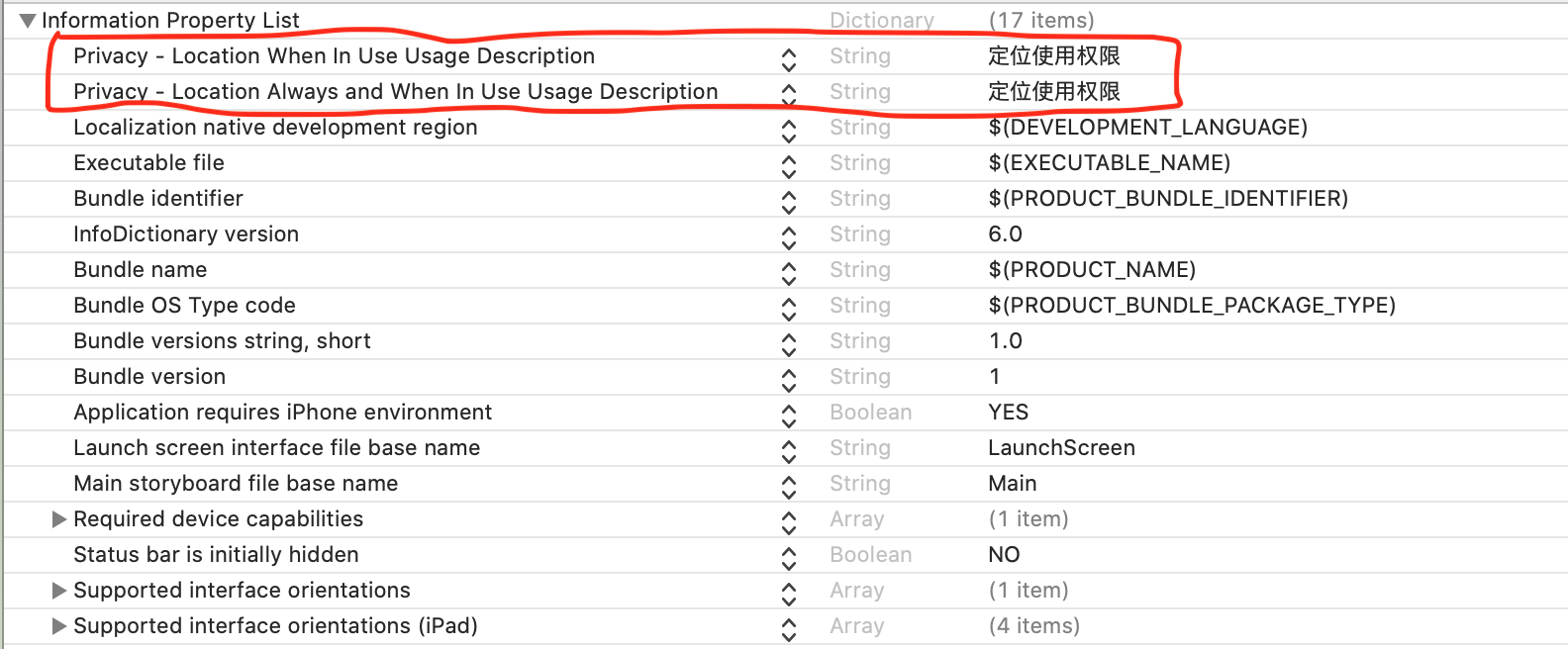需求:打开APP获取用户所在城市
通过用系统CLLocationManager来实现,步骤如下:
1.在项目的Info.plist中添加两个字段,如下图所示:

2.在AppDelegate中初始化CLLocationManager对象,代码如下:
#import "AppDelegate.h" #import <CoreLocation/CoreLocation.h> #import "MainViewController.h" @interface AppDelegate ()<CLLocationManagerDelegate> @property(nonatomic,strong)CLLocationManager *locationManager; @end @implementation AppDelegate - (BOOL)application:(UIApplication *)application didFinishLaunchingWithOptions:(NSDictionary *)launchOptions { // Override point for customization after application launch. //判断是否有定位权限 if ([CLLocationManager locationServicesEnabled]) { // 开启定位 [self.locationManager startUpdatingLocation]; }else{ NSLog(@"系统定位尚未打开,请到【设置-隐私-定位服务】中手动打开"); } return YES; } #pragma mark -定位设置 -(CLLocationManager *)locationManager{ if (!_locationManager) { // 创建CoreLocation管理对象 CLLocationManager *locationManager = [[CLLocationManager alloc]init]; // 定位权限检查 [locationManager requestWhenInUseAuthorization]; // 设定定位精准度 [locationManager setDesiredAccuracy:kCLLocationAccuracyBest]; // 设置代理 locationManager.delegate = self; _locationManager = locationManager; } return _locationManager; }
3.实现CLLocationManager相应的代理方法,代码如下
#pragma mark -代理方法,定位权限检查 -(void)locationManager:(CLLocationManager *)manager didChangeAuthorizationStatus:(CLAuthorizationStatus)status{ switch (status) { case kCLAuthorizationStatusNotDetermined:{ NSLog(@"用户还未决定授权"); // 主动获得授权 [self.locationManager requestWhenInUseAuthorization]; break; } case kCLAuthorizationStatusRestricted: { NSLog(@"访问受限"); // 主动获得授权 [self.locationManager requestWhenInUseAuthorization]; break; } case kCLAuthorizationStatusDenied:{ // 此时使用主动获取方法也不能申请定位权限 // 类方法,判断是否开启定位服务 if ([CLLocationManager locationServicesEnabled]) { NSLog(@"定位服务开启,被拒绝"); } else { NSLog(@"定位服务关闭,不可用"); } break; } case kCLAuthorizationStatusAuthorizedAlways:{ NSLog(@"获得前后台授权"); break; } case kCLAuthorizationStatusAuthorizedWhenInUse:{ NSLog(@"获得前台授权"); break; } default: break; } } #pragma mark -获取位置 - (void)locationManager:(CLLocationManager *)manager didUpdateLocations:(NSArray *)locations{ CLLocation * newLocation = [locations lastObject]; // 判空处理 if (newLocation.horizontalAccuracy < 0) { NSLog(@"定位失败,请检查手机网络以及定位"); return; } //停止定位 [self.locationManager stopUpdatingLocation]; // 获取定位经纬度 // CLLocationCoordinate2D coor2D = newLocation.coordinate; // NSLog(@"纬度为:%f, 经度为:%f", coor2D.latitude, coor2D.longitude); // 创建编码对象,获取所在城市 CLGeocoder *geocoder = [[CLGeocoder alloc] init]; // 反地理编码 [geocoder reverseGeocodeLocation:newLocation completionHandler:^(NSArray<CLPlacemark *> * _Nullable placemarks, NSError * _Nullable error) { if (error != nil || placemarks.count == 0) { return ; } // 获取地标 CLPlacemark *placeMark = [placemarks firstObject]; // NSLog(@"获取地标 = %@,",placeMark.locality); }]; } #pragma mark -定位失败 - (void)locationManager:(CLLocationManager *)manager didFailWithError:(NSError *)error{ // NSLog(@"定位失败,请检查手机网络以及定位"); }